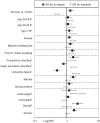Daily physical activities and sports in adult survivors of childhood cancer and healthy controls: a population-based questionnaire survey
- PMID: 22506058
- PMCID: PMC3323587
- DOI: 10.1371/journal.pone.0034930
Daily physical activities and sports in adult survivors of childhood cancer and healthy controls: a population-based questionnaire survey
Abstract
Background: Healthy lifestyle including sufficient physical activity may mitigate or prevent adverse long-term effects of childhood cancer. We described daily physical activities and sports in childhood cancer survivors and controls, and assessed determinants of both activity patterns.
Methodology/principal findings: The Swiss Childhood Cancer Survivor Study is a questionnaire survey including all children diagnosed with cancer 1976-2003 at age 0-15 years, registered in the Swiss Childhood Cancer Registry, who survived ≥5 years and reached adulthood (≥20 years). Controls came from the population-based Swiss Health Survey. We compared the two populations and determined risk factors for both outcomes in separate multivariable logistic regression models. The sample included 1058 survivors and 5593 controls (response rates 78% and 66%). Sufficient daily physical activities were reported by 52% (n = 521) of survivors and 37% (n = 2069) of controls (p<0.001). In contrast, 62% (n = 640) of survivors and 65% (n = 3635) of controls reported engaging in sports (p = 0.067). Risk factors for insufficient daily activities in both populations were: older age (OR for ≥35 years: 1.5, 95CI 1.2-2.0), female gender (OR 1.6, 95CI 1.3-1.9), French/Italian Speaking (OR 1.4, 95CI 1.1-1.7), and higher education (OR for university education: 2.0, 95CI 1.5-2.6). Risk factors for no sports were: being a survivor (OR 1.3, 95CI 1.1-1.6), older age (OR for ≥35 years: 1.4, 95CI 1.1-1.8), migration background (OR 1.5, 95CI 1.3-1.8), French/Italian speaking (OR 1.4, 95CI 1.2-1.7), lower education (OR for compulsory schooling only: 1.6, 95CI 1.2-2.2), being married (OR 1.7, 95CI 1.5-2.0), having children (OR 1.3, 95CI 1.4-1.9), obesity (OR 2.4, 95CI 1.7-3.3), and smoking (OR 1.7, 95CI 1.5-2.1). Type of diagnosis was only associated with sports.
Conclusions/significance: Physical activity levels in survivors were lower than recommended, but comparable to controls and mainly determined by socio-demographic and cultural factors. Strategies to improve physical activity levels could be similar as for the general population.
Conflict of interest statement
Figures



References
-
- Gatta G, Zigon G, Capocaccia R, Coebergh JW, Desandes E, et al. Survival of European children and young adults with cancer diagnosed 1995–2002. European Journal of Cancer. 2009;45:992–1005. - PubMed
-
- Jemal A, Siegel R, Xu J, Ward E. Cancer Statistics, 2010. CA Cancer J Clin. 2010;60:277–300. - PubMed
-
- Oeffinger KC, Mertens AC, Sklar CA, Kawashima T, Hudson MM, et al. Chronic Health Conditions in Adult Survivors of Childhood Cancer. New England Journal of Medicine. 2006;355:1572–1582. - PubMed
-
- Alvarez JA, Scully RE, Miller TL, Armstrong FD, Constine LS, et al. Long-term effects of treatments for childhood cancers. Current Opinion in Pediatrics. 2007;19:23–31. - PubMed

